In a new study conducted by Wisconsin Safety Council (WSC) and Rural Mutual Insurance Company, 85% of respondents said they “sometimes” or “often” see a coworker come to work sick even though he/she should have stayed home. In the current environment, exposure to sick coworkers is the leading safety concern for workers in Wisconsin. In Read more
COVID

In a new study conducted by Wisconsin Safety Council (WSC) and Rural Mutual Insurance Company, 85% of respondents said they “sometimes” or “often” see a coworker come to work sick even though he/she should have stayed home. In the current environment, exposure to sick coworkers is the leading safety concern for workers in Wisconsin.
In an effort to identify top workplace safety concerns and provide solutions during National Safety Month in June, WSC and Rural Mutual polled more than 180 WSC members, the majority of whom are safety professionals working in Wisconsin trades, including contractors, manufacturers and construction workers. The study was completed in April.
“Amidst the COVID-19 pandemic, we know businesses and organizations across the state are looking to create safer work environments now more than ever,” said Aaron Huebner, WSC executive director. “This study revealed safety professionals should focus on establishing initiatives that prevent the spread of infection and reduce exposure to employees who are sick.”
Business owners can protect their employees by taking business insurance that compensates their workers against workplace illnesses and other liability policies. Contrary to common belief, a business insurance policy does not protect the business and abandon its employees; it protects the employees just as much by offering compensation for injuries and health concerns that arise in the workplace.
Once a group of workers get infected while on the job, it is the employer’s duty to protect them and the rest of the workers by providing a suitable environment. Unaffected workers still need to do their jobs and have a right to do so in a suitable environment.
Simultaneously, it’s the affected workers’ prerogative to go back to work after receiving medical attention. It can only be possible for these to happen if a business has an insurance cover to indemnify its worker while protecting its practices.
Consequently, business insurance is a critical step in running your business while you, the employer, focus on your employees’ needs.
The respondents indicated several other top safety risks in the workplace:
- Interacting with hazardous materials (80%)
- Driving for work-related activities (80%)
- Standing for more than two hours in a row (79%)
- Working in high noise levels where a raised voice is needed to talk to people less than four feet away (76%)
A new, free e-book from Rural Mutual and WSC is now available to help safety professionals and trade workers in Wisconsin address these leading safety concerns. The ‘Work Safe in Wisconsin’ e-book offers easy to implement solutions for a safer and healthier workplace.
“Helping Wisconsin businesses lower their safety risks is a big part of Rural’s mission,” said Chris Schlechta, safety and loss control manager at Rural Mutual. “We’re excited to work with WSC to introduce the ‘Work Safe in Wisconsin’ e-book in hopes to inspire workers to jumpstart safety initiatives during National Safety Month and throughout the year.”
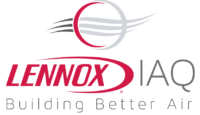
New program empowers HVAC service leaders to implement advanced IAQ solutions for commercial facilities across the nation Lennox International, a global leader in the heating, air conditioning, and refrigeration markets, has announced additional training that will provide contractors with the proper knowledge to help improve indoor air quality (IAQ) through their Building Better Air initiative Read more
New program empowers HVAC service leaders to implement advanced IAQ solutions for commercial facilities across the nation
Lennox International, a global leader in the heating, air conditioning, and refrigeration markets, has announced additional training that will provide contractors with the proper knowledge to help improve indoor air quality (IAQ) through their Building Better Air initiative.
The Building Better Air training program provides a structure to improve indoor air quality of commercial spaces through the Evaluate, Solve, Maintain framework. Contractors trained through the program will have key information to explain how HVAC systems impact IAQ and offer the right solutions for their clients.
“Contractors are seeing an increased demand for IAQ solutions recently with the second wave of COVID-19,” said Elliot Zimmer, president and Chief Operating Officer of Lennox Commercial. “Our training program will help provide contractors with the support system they need to assess equipment and make a proper recommendation to better improve IAQ for their customers’ facilities.
“Our strong partnership with our Lennox Commercial Alliance Contractor network gives us a unique ability to help buildings improve their indoor air quality and get back to business safely.”
In October, Lennox introduced the Building Better Air initiative, which helps facilities evaluate the state of their HVAC systems by using an IAQ survey and creates solutions tailored to the needs of the building. The training program is an additional step to further Lennox’s goal to create safe working environments for restaurants, movie theaters, schools, offices and similar facilities.
“Our goal is to help businesses return to a normal routine safely, and improved indoor air quality is a great start,” said Bobby DiFulgentiz, vice president of product management and marketing. “If COVID-19 has taught us anything, it has shown just how important HVAC is in our everyday life. We are focusing our efforts on spreading the knowledge we have on air purification, ventilation, and humidity control so that our customers have access to the right solutions to safely return to business.”
For more information about the Building Better Air initiative or to find a qualified contractor in your area, visit www.lennoxcommercial.com/buildingbetterair.
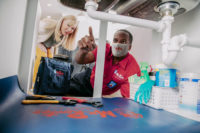
There’s a long-held assumption that the more technology you introduce to your business model, the less human interaction you get. Unfortunately, this rationale causes many businesses to put so much emphasis on their digital capabilities that customer service standards go to the wayside. When you’re in the business of plumbing, delivering your essential services will Read more
There’s a long-held assumption that the more technology you introduce to your business model, the less human interaction you get. Unfortunately, this rationale causes many businesses to put so much emphasis on their digital capabilities that customer service standards go to the wayside.
When you’re in the business of plumbing, delivering your essential services will always require interaction with your customers at some stage of the process. Therefore, providing poor customer service and hoping your advanced technology makes up for it might as well be a death sentence for your business.
In reality, technology should not be seen as a replacement for excellent customer service, but rather as a necessary tool for enhancing the overall customer experience.

For Mr. Rooter Plumbing, a Neighborly company, we’ve found in recent years that not only does implementing various advanced plumbing technologies such as the use of video inspection equipment or video conferencing and consultations improve the work we do in the homes of our customers but incorporating technology into the customer relations aspect of our business has led to happier, more loyal customers across our global network. Here’s why…
Customers want convenience, and so do providers
Today’s consumers make their purchase decisions based primarily on convenience and instant gratification. Which restaurant is available and can deliver quickest through my favorite food delivery app? Which clothing store has a user-friendly website and offers free two-day shipping? The same mindset comes into play when looking for a home service provider: Which plumber is easiest to contact and can get the job done most efficiently?
Always try to think from the customer’s perspective. If someone is in need of a plumber, chances are they are stressed enough as it is. The least you can do for them is simplify the request and scheduling process with online and mobile options. Ideally, this simplifies things for you as the contractor as well. There is no need to invest all of your time, talent and resources in creating an intricate website for online scheduling, when the best approach is to make it simple and attractive with consumer-friendly usability. The more user-friendly your system is, the more customers you’ll attract. And with more customers, there’s a greater need for an intuitive system to help you keep track of those leads.
Technology can play a particularly important part in helping to improve the efficiency of phone systems. If you are a larger plumbing company that receives frequent phone calls, you may want to consider using technology to organize calls so that fewer calls are missed. This could include using call center workforce management software to allocate calls along with virtual phone menus.
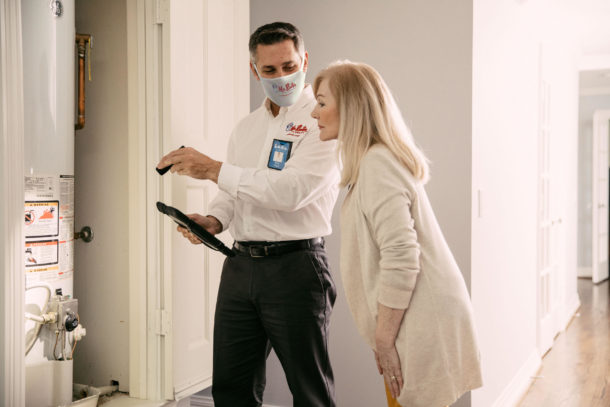
Customers expect professionalism
If a homeowner is paying a professional to complete a home service project for them, they want to feel confident that their money is going toward someone who knows what they’re doing. In the past, a plumber’s success was based on how well they could “paint a verbal picture” of the issue and its solution for a customer. Nowadays, a plumber who arrives with a mobile device or tablet ready to visually explain their recommended approach instantly increases his/her credibility as a trusted advisor as opposed to a salesman. Figuring out how to appropriately use technology to convey expertise is a skill that requires more advanced and ongoing training of your technicians, but it’s worthwhile to ensure your team can respond to service requests with the utmost professionalism.
Electronic communication also streamlines transactions between providers and customers. Invoices can be delivered directly via email so they don’t get lost in the mail. Messages can be sent and received in real time so there’s no frustration over playing phone tag. Customers can better prepare a technician for their visit by sending photos and videos of the issue at hand, which makes for a more prepared technician upon arrival. All of this conveys the image you want of an experienced and professional provider.
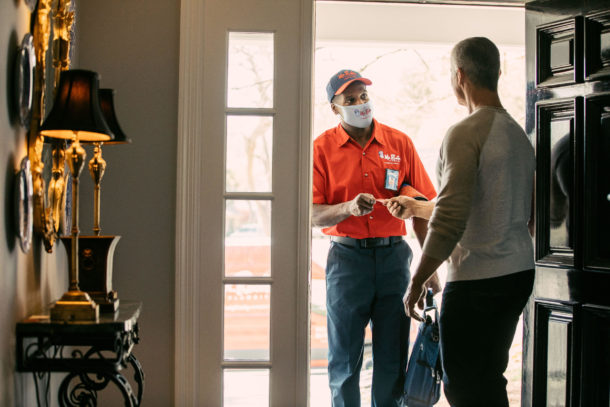
Customers want to feel safe
Being an essential service provider during a pandemic is both an opportunity and a challenge. While issues that require a plumber cannot be ignored, it is also a health risk both to the homeowner and to the technician alike for us to deliver those services directly to an individual’s home. Being invited into people’s homes in order to do our jobs is a privilege, especially in today’s environment, making it absolutely necessary to work safety measures such as wearing masks, washing hands, maintaining social distance, and more into our standard service call procedures.
With technology, we can take our precautionary measures a step further to create an experience as close to contactless as possible. Electronic capabilities for transactions such as providing estimates, sending invoices, and receiving payments are a must. For the service call itself, being digitally connected with our customers allows us to send arrival alerts, to pre-screen customers, and to possibly even provide expertise and direction entirely virtually for select home maintenance jobs that homeowners could accomplish themselves. By introducing these creative approaches to doing what is usually a very hands-on job, we show our customers that we realize giving them the best and most comfortable experience goes far beyond the job itself.
The time to evolve is now
Of course, the idea of implementing all of this advanced technology to your plumbing business may be a daunting concept for some contractors. You might even question if it’s worthwhile if the old-school business model you’ve always had is still working as far as you can tell. But with the growing prevalence of technology across all industries, chances are refusing to adapt will leave you behind your competitors who are rising to the occasion.
If you’re not comfortable making the changes yourself, consider hiring a consultant or perhaps even converting your business to a franchise model like Mr. Rooter to get the digital support you need. But one way or another, it’s time for your plumbing business to step into the future.
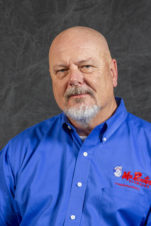 Glenn Gallas is the Vice President of Operations for Mr. Rooter Plumbing, a Neighborly company. Glenn’s career in franchising began as a franchise owner in 2000 of a Mr. Rooter Plumbing franchise. Glenn became a multi-franchise owner when he purchased a Mr. Electric franchise and then a Holiday Lighting franchise. Glenn is a veteran and has served in the US Army in both the active and reserve capacity and sees franchising as the best fit opportunity for veterans transitioning from the military to civilian life.
Glenn Gallas is the Vice President of Operations for Mr. Rooter Plumbing, a Neighborly company. Glenn’s career in franchising began as a franchise owner in 2000 of a Mr. Rooter Plumbing franchise. Glenn became a multi-franchise owner when he purchased a Mr. Electric franchise and then a Holiday Lighting franchise. Glenn is a veteran and has served in the US Army in both the active and reserve capacity and sees franchising as the best fit opportunity for veterans transitioning from the military to civilian life.
